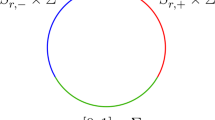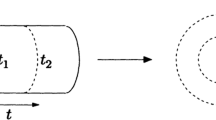Summary
A Lagrangian formalism invariant under the gauge groupU 1 ⊗USp 2,2 is set up in terms of spinor fields defined on a fiber bundle with Cartan connexion. The fiber of the Cartan bundle over space-time associated with strong interactions is characterized by an elementary length parameterR related to the range of the strong forces, and the structural groupUSp 2,2 of the bundle (being the covering group of theSO 4,1 de Sitter group) implies a gauge description of strong interactions based on the noncompact gauge groupUSp 2,2. TheU 1 factor in the total gauge group corresponds to the usual gauge formulation for the electromagnetic interactions. The positivity of the energy associated with stable extended one-particle states in this dualistic description of charged hadronic matter immersed in the fiber geometry (we call this dualism strong fiber dynamics (SFD)) requires hadrons to be assigned to representations of the compact subgroupSU 2 ⊗SU 2 of the strong-interaction gauge groupUSp 2,2. A brief discussion of the point-particle limitR → 0 is given by linking the presented SFD formalism for extended hadrons to an idealized description in terms of operators in a local quantum field theory.
Riassunto
Si costruisce un formalismo Lagrangiano invariante rispetto al gruppo di gaugeU 1 ⊗USp 2,2 in termini di campi spinoriali definiti su un fascio di fibre con connessioni di Cartan. La fibra del fascio di Cartan sullo spazio-tempo associato con le interazioni forti è caratterizzata da un parametro elementare di lunghezza,R, collegato al valore delle forze forti, e il gruppo strutturaleUSp 2,2 del fascio (che è il gruppo di copertura del gruppo di de SitterSO 4,1) implica una descrizione di gauge delle interazioni forti basata sul gruppo di gauge non compattoUSp 2,2. Il fattoreU 1 nel gruppo di gauge totale corrisponde all’usuale formulazione di gauge per le interazioni elettromagnetiche. La positività dell’energia associata a stati stabili, estesi, ad una particella in questa descrizione dualistica della materia adronica carica immersa nella geometria delle fibre (questa geometria è chiamata dinamica forte delle fibre (SFD)) richiede che gli adroni siano assegnati a rappresentazioni del sottogruppo compattoSU 2⊗SU 2 del gruppo di gauge dell’interazione forteUSp 2,2. Si presenta una breve discussione del limite della particella puntiformeR→0 collegando il presente formalismo della SFD per adroni estesi ad una descrizione idealizzata in termini di operatori in una teoria locale quantistica dei campi.
Реэюме
Раэвивается Лагранжев формалиэм, инвариантный относительно калибровочной группыU 1 ⊗USp 2,2 в терминах спинорных полей, определенных на семействе нитей со свяэью Картана. Нить семейства Картана в пространстве и времени, свяэанных с сильными вэаимодействиями, характериэуется параметром злементарной длины В, который определяет область сильных сил. Структурная группаUSp 2,2 зтого семейства (которая является охватываюшей группой для группыSO 4,1 де Ситтера) подраэумевает калибровочное описание сильных вэаимодействий, основанное на некомпактной калибровочной группеUSp 2,2. ФакторU 1 в полной калибровочной группе соответствует обычной калибровочной формулировке для злектромагнитных вэаимодействий. Положительность знергии, свяэанная с устойчивыми протяженными одночастичными состояниями в зтом дуалистическом описании эаряженного адронного вешества, погруженного в геометрию нити (мы наэываем зтот дуалиэм сильной динамикой нити), требует, чтобы адроны были приписаны представлениям компактной подгруппыSU 2 ⊗SU 2 калибровочной группы сильных вэаимодействийUSp 2,2. Проводится обсуждение предела точечных частицR→0, который свяэывает предложенный формалиэм сильной динамики нити для протяженных адронов с идеалиэированным описанием череэ операторы квантовой теории поля.
Similar content being viewed by others
References
W. Drechsler:Fortschr. Phys.,23, 607 (1975).
W. Drechsler:Currents in a theory of strong interactions based on a fiber bundle geometry, to be published inFound. Phys.
C. N. Yang andR. L. Mills:Phys. Rev.,96, 191 (1954).
R. Utiyama:Phys. Rev.,101, 1597 (1956).
Compare ref. (7).
W. Drechsler:Phys. Lett.,66 B, 439 (1977).
For the exact definition of a fiber bundle with Cartan connexion used in this paper see ref. (9) and the literature quoted there.
W. Drechsler:Journ. Math. Phys.,18, 1358 (1977).
The representation character ofψ(x, ξ) with respect to the Lorentz group operating in the base space and with respect to the de Sitter group operating in the fiber (the strong-interaction part) is factorized in eq. (14). However,φ s(ξ) is stillx-dependent, which is a consequence of the fact that the bundle is not a trivial bundle which would beglobally a direct product of space-time and a de Sitter space. TheU 1 gauge group referring to electromagnetism goes with the Dirac factorϕ(x) as in the conventional formalism (compare ref. (13)).
S. Mandelstam:Ann. of Phys.,19, 1 (1962).
J. D. Bjorken andS. D. Drell:Relativistic Quantum Fields (New York, N. Y., 1965).
I. M. Gel’fand, M. I. Graev andN. Ya. Vilenkin:Generalized Functions, Vol.5, Chapt. V (London, 1966).
The idea here is similar to the proposal to embed theSO 4 symmetry group of the nonrelativistic hydrogen atom into a bigger noncompact (so-called dynamical) group—for exampleSO 4,1 (compare ref. (27,28) and the literature quoted there, and alsoBöhm (29) for the elementary-particle case)—with the noncompact generators inducing transitions between the energy levels determined from theSO 4 symmetry. The essential difference in the discussion here is that we regard the noncompact groupSO 4,1 (or rather its covering groupsUSp 2,2) as agauge group being the structural group of a fiber bundle of Cartan type over space-time with the relevance of the bundle being motivated on geometrical grounds (see ref. (1,2,9)).
H. Bacry:Nuovo Cimento,41, 222 (1966).
M. Bander andC. Itzykson:Rev. Mod. Phys.,38, 330 (1966).
A. Böhm:Phys. Rev.,145, 1212 (1966).
S. Kobayashi andK. Nomizu:Foundation of Differential Geometry, Vol.1 (New York, N. Y., 1963).
The curvature radiusR ofV l4 (x) enters the formulae for the stereographic projection (see the appendix of ref. (1)).
Author information
Authors and Affiliations
Rights and permissions
About this article
Cite this article
Drechsler, W. Lagrangian formulation for a gauge theory of strong and electromagnetic interactions defined on a cartan bundle.. Nuov Cim A 41, 597–620 (1977). https://doi.org/10.1007/BF02730264
Received:
Published:
Issue Date:
DOI: https://doi.org/10.1007/BF02730264




